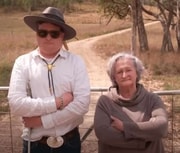Woman dead for 24 minutes shares shocking experience that challenges sceptics
By
Gian T
- Replies 7
The concept of an afterlife has been a topic of debate and fascination for centuries, with sceptics and believers often at odds over the existence of a realm beyond our mortal coil.
However, the story of one individual's brush with death may offer a compelling glimpse into what lies beyond, challenging even the staunchest sceptics to reconsider their stance.
Tessa Romero, a 50-year-old sociologist from southern Spain, experienced what many would call the impossible.
She 'died' for 24 minutes and returned with a story that has the power to change our understanding of life and death.
On what seemed like a routine school run, Romero's life took an unexpected turn when she suffered a suspected sudden cardiac arrest.
For 24 harrowing minutes, she was clinically dead. The ambulance arrived, and the medical team worked tirelessly to revive her.
In her book, 24-Minutes on the Other Side: Living Without Fear of Death, Romero recounted the confusion among the doctors, who debated whether she had experienced an acute myocardial infarction or a sudden cardiac arrest.
The exact cause of her condition remained a mystery.
But it's what Romero experienced during those 24 minutes that is truly remarkable.
She described an overwhelming sense of peace, a cessation of all physical and emotional pain.
She recalled floating above the scene, observing the clinic and her daughters in the waiting room.
She saw her own body lying there, yet felt more alive than ever, awake and conscious, but invisible and unheard by those around her.
Before this experience, Romero had been sceptical of the afterlife, but what she encountered was so real and profound that it transformed her beliefs entirely.
She spoke of a world that seemed to operate under different rules, where time moved slower, and everything was imbued with deeper meaning.
Romero's health had been in decline for several months before her near-death experience, with doctors unable to diagnose her mysterious condition.
Post-recovery, she has been in contact with surgeons, neurologists, and researchers who study near-death phenomena.
Some suggested that her physical ailments may have been manifestations of her emotional state during a tough period in her life.
The impact of Romero's experience extends far beyond the personal.
It has altered her perspective on life and death, erasing her fear of the latter.
She now views death not as an end but as a transition to a place of understanding, love, and peace.
Scientifically, there is some basis for experiences like Romero's. Studies have shown that the human brain can function for a short time after the heart stops and can even exhibit bursts of activity during resuscitation, long after it appears inactive on scans.
These findings have sparked discussions among medical professionals about the criteria for declaring death, suggesting that resuscitation may still be possible even after several minutes of oxygen deprivation to the brain.
Many people have reported out-of-body experiences, encounters with bright lights, or meetings with deceased relatives during clinical death.
While the exact reasons for these shared experiences remain a topic of debate, some experts theorise that the brain's 'brakes' are released during these moments, allowing for vivid and lucid perceptions of memories.
Romero's story is a testament to the mysteries surrounding the human experience.
It challenges us to keep an open mind about what happens after we take our last breath.
Whether you're a sceptic or a believer, stories like these invite us to explore the possibilities of what lies beyond and perhaps find comfort in the notion that our existence might continue in ways we have yet to understand.

Have you or someone you know had a similar experience? Do you believe there's something more after we depart this life? Join the conversation and let us know in the comments below.
However, the story of one individual's brush with death may offer a compelling glimpse into what lies beyond, challenging even the staunchest sceptics to reconsider their stance.
Tessa Romero, a 50-year-old sociologist from southern Spain, experienced what many would call the impossible.
She 'died' for 24 minutes and returned with a story that has the power to change our understanding of life and death.
On what seemed like a routine school run, Romero's life took an unexpected turn when she suffered a suspected sudden cardiac arrest.
For 24 harrowing minutes, she was clinically dead. The ambulance arrived, and the medical team worked tirelessly to revive her.
In her book, 24-Minutes on the Other Side: Living Without Fear of Death, Romero recounted the confusion among the doctors, who debated whether she had experienced an acute myocardial infarction or a sudden cardiac arrest.
The exact cause of her condition remained a mystery.
But it's what Romero experienced during those 24 minutes that is truly remarkable.
She described an overwhelming sense of peace, a cessation of all physical and emotional pain.
She recalled floating above the scene, observing the clinic and her daughters in the waiting room.
She saw her own body lying there, yet felt more alive than ever, awake and conscious, but invisible and unheard by those around her.
Before this experience, Romero had been sceptical of the afterlife, but what she encountered was so real and profound that it transformed her beliefs entirely.
She spoke of a world that seemed to operate under different rules, where time moved slower, and everything was imbued with deeper meaning.
Romero's health had been in decline for several months before her near-death experience, with doctors unable to diagnose her mysterious condition.
Post-recovery, she has been in contact with surgeons, neurologists, and researchers who study near-death phenomena.
Some suggested that her physical ailments may have been manifestations of her emotional state during a tough period in her life.
The impact of Romero's experience extends far beyond the personal.
It has altered her perspective on life and death, erasing her fear of the latter.
She now views death not as an end but as a transition to a place of understanding, love, and peace.
Scientifically, there is some basis for experiences like Romero's. Studies have shown that the human brain can function for a short time after the heart stops and can even exhibit bursts of activity during resuscitation, long after it appears inactive on scans.
These findings have sparked discussions among medical professionals about the criteria for declaring death, suggesting that resuscitation may still be possible even after several minutes of oxygen deprivation to the brain.
Many people have reported out-of-body experiences, encounters with bright lights, or meetings with deceased relatives during clinical death.
While the exact reasons for these shared experiences remain a topic of debate, some experts theorise that the brain's 'brakes' are released during these moments, allowing for vivid and lucid perceptions of memories.
Romero's story is a testament to the mysteries surrounding the human experience.
It challenges us to keep an open mind about what happens after we take our last breath.
Whether you're a sceptic or a believer, stories like these invite us to explore the possibilities of what lies beyond and perhaps find comfort in the notion that our existence might continue in ways we have yet to understand.
Key Takeaways
- Tessa Romero, a 50-year-old woman, claimed to have 'died' for 24 minutes, during which she experienced peace and saw 'the other side,' altering her perspective on the afterlife.
- She recounted the experience in her book, stating it has made her no longer afraid of dying, following a suspected sudden cardiac arrest.
- Ms Romero describes feeling immense peace and witnessing out-of-body occurrences during the ordeal, challenging her former scepticism about the afterlife.
- Scientific studies suggest that the brain can remain active briefly after the heart stops, potentially explaining some near-death experiences. However, the exact reasons for these experiences are still debated among experts.








